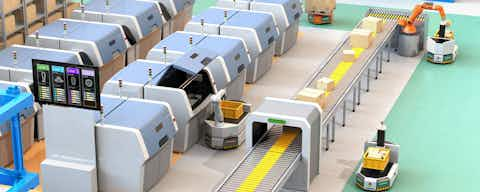- Blog
The promise of the digital factory
Smart manufacturing is shaping the future. Catch the wave now

You may have heard people refer to the digital factory or the brilliant factory. Some just call it smart manufacturing. Whatever its name, however, the term describes an evolving era in which manufacturing processes and operations are as much digital as they are physical. New technological advancements – all part of an ongoing Fourth Industrial Revolution (4IR) – have raised our awareness of this trend.
Challenges facing smart manufacturing
Yet converting from customary manufacturing to smart manufacturing takes a lot more work than typical IT transformation projects do. The reason: Deploying the Industrial Internet of Things (IIoT) in a factory is much more complex. Smart manufacturing solutions generally must pervade both operating technology (OT) and information technology (IT) – traditionally siloed domains.
What's more, making the shift calls for a strong governance model. The IIoT brings with it a number of process and operational changes that dig deep into human functions, and the ripple effect can impact the whole organization.
Finally, the switchover creates the need for major physical changes – retrofitting sensors, installing data acquisition modules, and creating infrastructure to stream data, to name some.
What smart manufacturing offers
Given these challenges, you might wonder why companies bother with IIoT-enabled smart manufacturing in the first place. Isn't the status quo good enough? Not really, because smart manufacturing promises many benefits. These include:
- More visibility into KPIs to improve and measure performance, to speed up decision-making and to introduce new products for manufacture faster
- Improved overall equipment efficiency for better machine use and higher outputs
- Consistent output and improved on-time delivery
- Improved quality, reduced waste, and less corrective work
- More efficient use of labor, utilities, raw materials, and capacity
- Reduced unplanned downtime by ensuring machines are safe and in good condition so planned disruptions are as short as possible
- Improved health and safety conditions
- Improved supply chain integration
- Improved after-market services
Of course, this list isn't exhaustive. As well, outcomes vary depending on the industry, the domain, the maturity level, geography, and other conditions.
Where to start?
As the first step along the journey to converting your manufacturing facility into a digital one, you'll need a holistic view of the factory floor. That includes taking a look at key KPIs as they relate to both connected and non-connected devices.
Smart manufacturing offers so many possibilities – condition-based monitoring, predictive maintenance, spare part optimization, track-and-trace visibility, and so on – that deciding where to start can be daunting. That's especially so because there are unique advantages to each solution. But with a full picture of operations, you can narrow your focus and prioritize the operations and phases that will deliver the quickest benefits.
Once you've determined what comes first, the next step should involve establishing strong links between your operational technology and your information technology. Doing so will give you the data you need for advanced analytics.
Then, with clear priorities and the valuable insights you derive from analytics, you can take the final step – setting up best-in-class benchmarks.
The brilliant factory – the future of manufacturing – is already changing the competitive landscape. If you want to keep your edge, the status quo won't do. Now is the time to get going.
